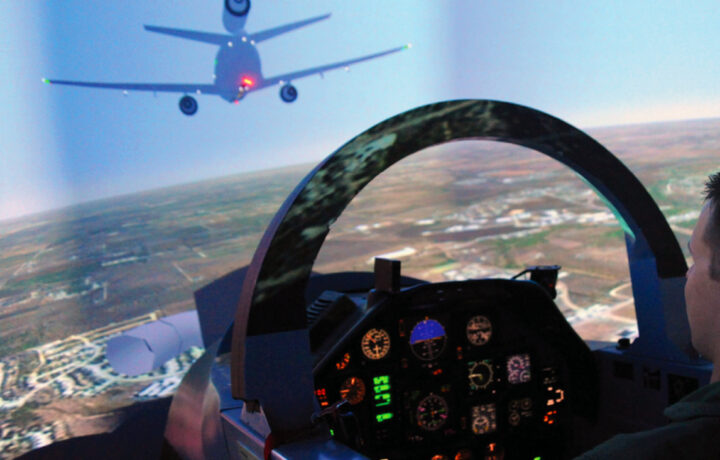Combat simulations like World of Tanks and War Thunder allow gamers to take part in matches even though the players can be continents apart. The United States military employs similar technology for training.
This month, the Northrop Grumman Corporation’s Distributed Mission Operations Network (DMON) enabled the Combat Air Force (CAF) Distributed Training Center (DTC) at Langley Air Force Base (AFB), VA, to successfully execute a large-force, virtual training event. For the first time, it also involved the United States Air Force’s fifth-generation F-22 Raptor and F-35 Lightning II stealth fighters.
DMON Argonne 23 provided training against peer adversaries in a complex, multi-domain threat scenario using networked aircraft simulators. The technology delivered secure connectivity and network interoperability between unique simulator platforms across the globe, which then allowed the aircrews to train together in a high-fidelity virtual environment.
“During this exercise, DMON connected fourth- and fifth-generation fighters from different bases to train as they would in live combat operations, allowing aircrews to prepare for the realistic tactical problems they may face,” said Rebecca Torzone, vice president and general manager, combat systems and mission readiness, Northrop Grumman. “DMON Argonne 23 successfully demonstrated how our immersive environments deliver on our commitment to prime warfighters for future Joint All-Domain Command and Control operations.”
Virtual Battlespace – Not a Game
In addition, the Northrop Grumman-staffed CAF DTC developed a robust virtual battlespace environment, mission planning and execution materials, and supported the scheduling, briefing, execution and debriefing. DMON also enabled operators to make changes in real time and adapt scenarios to mission training requirements.
Though it had the components of those video games, the technology is far more advanced – and utilizes advanced simulators for the actual aircraft. Over the course of four days, the event hosted 44 sites, 97 cockpits and trained 196 personnel operating simulators for the F-22 Raptor, F-35 Lightning II, F-16 Fighting Falcon, and A-10 Thunderbolt II, the U.S. Navy’s EA-18G. It also wasn’t just combat aircraft as the E-3G AWACS (Airborne Warning and Control System) and RC-135 reconnaissance aircraft were also included.
In addition, the simulation included the MQ-9 drone, and the JTAC (joint terminal attack controller).
According to Northrop Grumman, DMON is a proven, interoperable training network that connects legacy and emerging systems, and could serve as a foundational platform to support future requirements and capabilities such as the Joint Simulation Environment. Through “digital twins” of the battlespace, DMON can create a realistic, scalable environment for mission rehearsals and training.
Moreover, such virtual replicas combined with the ability to network a diverse set of nodes can save on resources, as there is no need to deploy people and equipment.
Simulations and the Military
The use of such technology is becoming increasingly common. Last fall, Houston-based HTX labs was awarded a $90 million contract to develop virtual reality content for the U.S. Air Force, while the service had previously tested a Virtual Reality Procedures Trainer (VRPT) trainer for its Cold War-era B-52 Stratofortress.
The VRPT offered an advantage as it could provide access to training tools that could be employed around the clock. In addition, as the technology is fairly compact – employing just VR goggles, a computer and two hand controls – it can be used almost anywhere and simulate a virtual B-52 cockpit.
Earlier this month, it was also reported that Microsoft was developed an “Immersive Intelligent Environment” (I3E) for the United States Space Force. That simulation will be powered by Microsoft’s HoloLens headset and feature a real-time display of orbital objects, while it will allow Space Force guardians to interact with them in an accurately scaled space environment.




